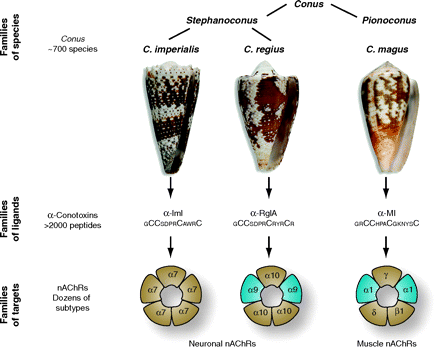
- Institution: Stanford Univ Med Ctr Lane Med Lib/Periodical Dept/Rm L109
- Sign In as Member / Individual
Diversity of the Neurotoxic Conus Peptides

A strategy for concerted discovery of ligand–target interactions and development. The figure provides a simplified overview of a single case study of concerted discovery. Representative species of cone snails are shown from two different subgeneric groups (clades): the worm-hunting Stephanoconus clade and the fish-hunting Pionoconus clade. From these and other Conus species, members of the α-conotoxin family, which generally target nicotinic acetylcholine receptors, were characterized. Different α-conotoxins are found in each species shown; however, the α-conotoxins from the closely related C. imperialis and C. regius (α-ImI and α-RgIA, respectively) are more similar to each other than the α-conotoxin from the distantly related C. magus (α-MI). α-ImI and α-RgIA also target closely related neuronal nAChRs; α7–α10 neuronal nAChRs are believed to form primarily homomeric pentamers. In contrast, α-MI targets the heteromeric nAChR expressed in muscle. The general concept of concerted discovery is that related species of animals produce related (but non-identical) ligands with specificity for related (but non-identical) targets.


